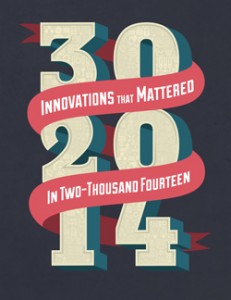 In the fast-paced world of technology, government often is the ham in the sandwich – one slice of bread is technological innovation and the other is budget restrictions and risk aversion. Finding balance between these opposing drives is an uphill battle, but many government agencies continue to step up to the challenge. 2014 marked another year of more technological innovations, and GovLoop’s new guide, Thirty Innovations the Mattered in 2014, highlights five of government’s major technology trendsetters in for the year:
In the fast-paced world of technology, government often is the ham in the sandwich – one slice of bread is technological innovation and the other is budget restrictions and risk aversion. Finding balance between these opposing drives is an uphill battle, but many government agencies continue to step up to the challenge. 2014 marked another year of more technological innovations, and GovLoop’s new guide, Thirty Innovations the Mattered in 2014, highlights five of government’s major technology trendsetters in for the year:
1) The Department of Interior’s United States Geological Survey (USGS): Under the guidance of the Federal Aviation Administration, the USGS is partnered with other Department of Interior agencies as well as academic, state, and local organizations to utilize unmanned aircraft systems (UAS) for operation and research purposes that are needed by the Department of the Interior. According to the USGS, UAS are answering scientific and natural resource questions by monitoring climate change in addition to documenting wildlife inventories, tracking climate change, and gathering remote sensing data for environmental conditions.
2) The U.S. Centers for Medicare and Medicaid Services: The U.S. Centers for Medicare and Medicaid Services are adapting Agile software development methods for Healthcare.gov. The administration has been trying to gather the right balance of people to solve the site’s operational problems since the 2013 technical issues of Healthcare.gov. Federal Computer Week states that the Centers are searching for a contractor to handle the IT infrastructure created in response to the 2010 healthcare law.
3) Los Angeles Police Department, California: Los Angeles crimes have now decreased for the tenth year in a row, and a major contributing factor to future decreasing is predictive policing. Predictive policing is resulting in some amazing crime reduction statistics from cities across the nation, such as Los Angeles, California. The Los Angeles Police Department uses predictive policing to reduce crimes in the city, which includes keeping them from occurring in the first place. In predictive policing, data is collected from different crimes, like shoplifting and car theft, and used in computer algorithms. As a result, areas with higher instances of specific crimes will receive more attention from patrolling cops.
4) The State of Colorado: Colorado created what’s called the iData platform, built to overcome past issues of limited data sharing capabilities. To save money for public citizens and the state, huge amounts of data collected by agencies called for a platform that could catalogue, analyze, and store the huge amounts of data collected by them in multiple ways. In response to the request for a new platform, the Office of Information Technology (OIT) created the Data Insights Platform (iData Platform).
5) Department of Energy: The Energy Department has created a cyber language to help streamline the process and clear up any confusion. Whether malicious or accidental, cyber breaches pose a serious and ongoing challenge for the Energy Department. Embedding cybersecurity protocols from the beginning in the procurement process is an important step. In April, the Energy Department created its own cybersecurity language, Cybersecurity Procurement Language for Energy Delivery Systems. According to the Energy Department, “[the] guidance document provides baseline cybersecurity procurement language for use by asset owners, operators, integrators, and suppliers during the procurement process.”
For more on these technology trendsetters and other innovations of this past year, download GovLoop’s new guide, Thirty Innovations the Mattered in 2014.





Leave a Reply
You must be logged in to post a comment.